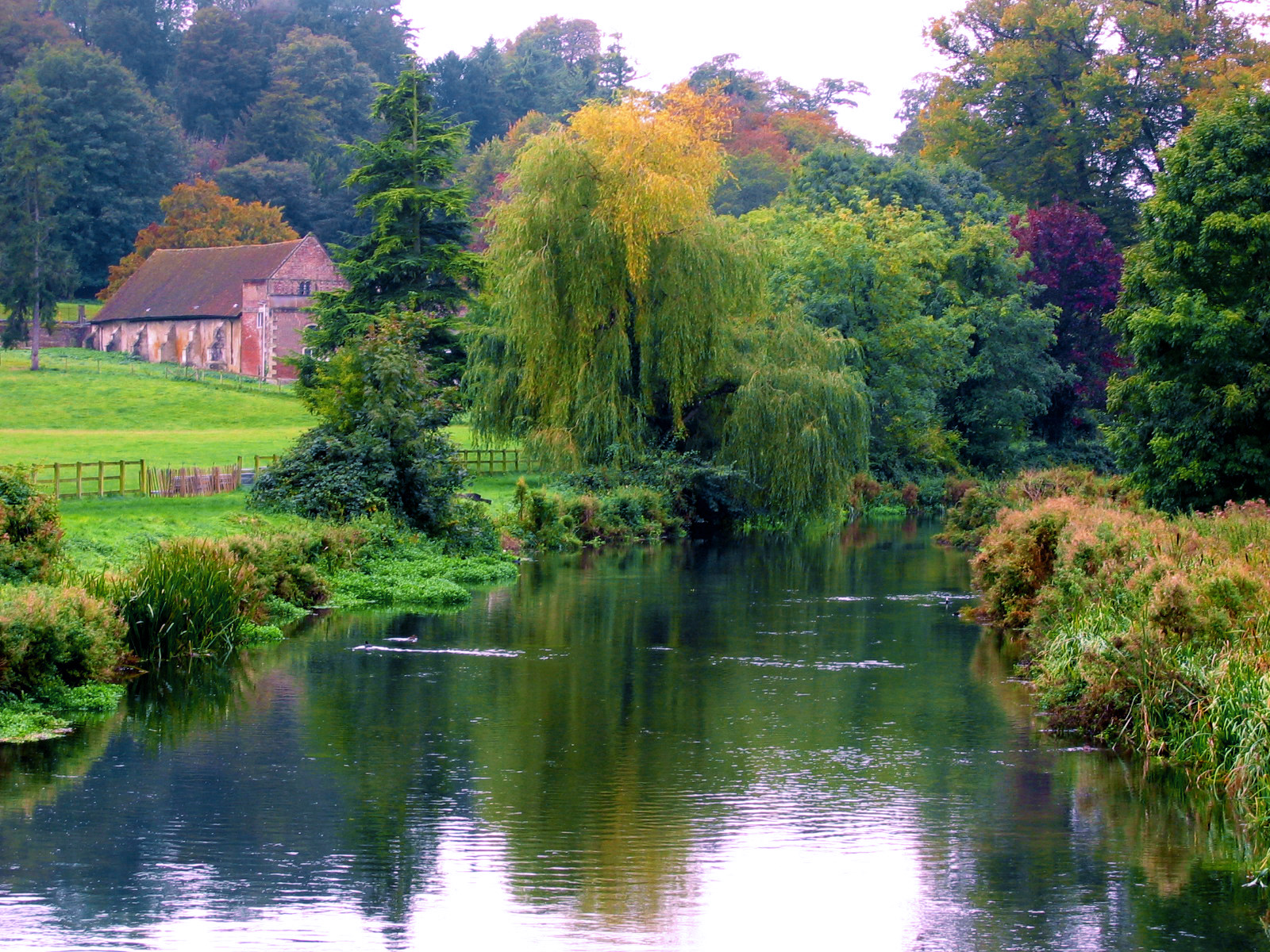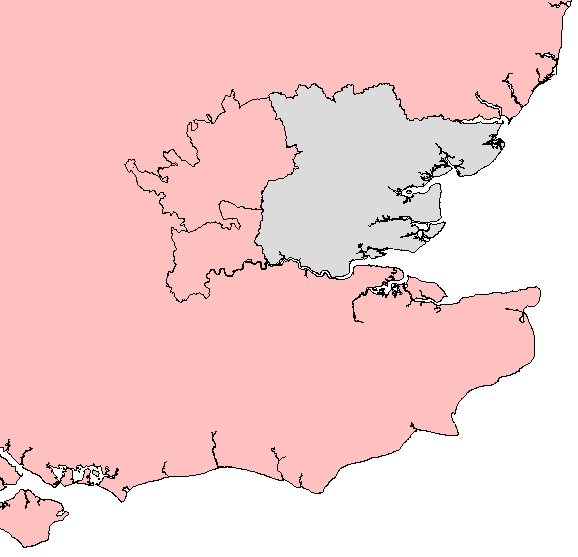|
Barking Abbey
Barking Abbey is a former royal monastery located in Barking, in the London Borough of Barking and Dagenham. It has been described as having been "one of the most important nunneries in the country". Originally established in the 7th century, from the late 10th century the abbey followed the Rule of St. Benedict. The abbey had a large endowment and sizeable income but suffered severely after 1377, when the River Thames flooded around of the abbey's land, which was unable to be reclaimed. Despite this, at the time of the dissolution it was still the third wealthiest nunnery in England. The abbey existed for almost 900 years, until its closure in 1539, as part of King Henry VIII's Dissolution of the Monasteries. It had many notable abbesses including several saints, former queens and the daughters of kings. The abbess of Barking held precedence over all other abbesses in England. The ruined remains of Barking Abbey now form part of a public open space known as Abbey Green. It ... [...More Info...] [...Related Items...] OR: [Wikipedia] [Google] [Baidu] |
St Margaret's Church, Barking
St Margaret's Church or the Church of St Margaret of Antioch is a Church of England parish church in Barking, East London. The church is a Grade I listed building built on a site dating back to the 13th century within the grounds of Barking Abbey, the ruins of a former royal monastery that was originally established in the 7th century. The building is dedicated to Margaret the Virgin. History Medieval It originated as a chapel for local people within the grounds of Barking Abbey, to the south of the Abbey church. Its oldest part is the chancel, built early in the 13th century during the reign of King John. The building is said to have been made into a parish church in 1300 by Anne de Vere, abbess of the Abbey. Until the 1390s Barking formed a rectory, held by the Abbey and divided into two vicarages known as 'Northstrete' (probably funded by income from the Ilford area) and 'Southstrete' (serving the Abbey church). The area suffered severe flooding in the late 14th century, ... [...More Info...] [...Related Items...] OR: [Wikipedia] [Google] [Baidu] |
Chertsey Abbey
Chertsey Abbey, dedicated to St Peter, was a Benedictine monastery located at Chertsey in the English county of Surrey. It was founded in 666 AD by Saint Erkenwald who was the first abbot, and from 675 AD the Bishop of London. At the same time he founded the abbey at Chertsey, Erkenwald founded Barking Abbey on the Thames east of London, where his sister Saint Ethelburga was the first abbess. Most of north-west Surrey was granted to the abbey by King Frithuwald of Surrey. Dark Age saints buried here include Saint Beocca, a Dark Ages Catholic Saint from Anglo-Saxon England buried here around 870 AD, and ninth century Saint Edor of Chertsey. In the 9th century it was sacked by the Danes and refounded from Abingdon Abbey by King Edgar of England in 964. In the eleventh century the monks engineered the Abbey River as an offshoot of the River Thames to supply power to the abbey's watermill. In late medieval times, the Abbey became famous as the burial place of King Henry VI ( ... [...More Info...] [...Related Items...] OR: [Wikipedia] [Google] [Baidu] |
Æthelred The Unready
Æthelred II ( ang, Æþelræd, ;Different spellings of this king’s name most commonly found in modern texts are "Ethelred" and "Æthelred" (or "Aethelred"), the latter being closer to the original Old English form . Compare the modern dialect word ., non, Aðalráðr 966 – 23 April 1016), known as Æthelred the Unready, was King of the English from 978 to 1013 and again from 1014 until his death in 1016. His epithet does not derive from the modern word " unready", but rather from the Old English meaning "poorly advised"; it is a pun on his name, which means "well advised". Æthelred was the son of King Edgar the Peaceful and Queen Ælfthryth. He came to the throne at about the age of 12, following the assassination of his older half-brother, King Edward the Martyr. The chief problem of Æthelred's reign was conflict with the Danes. After several decades of relative peace, Danish raids on English territory began again in earnest in the 980s, becoming mar ... [...More Info...] [...Related Items...] OR: [Wikipedia] [Google] [Baidu] |
Monks Horton
Monks Horton is a small civil parish in the Folkestone and Hythe district of Kent, England. It is located north of Hythe. Within the civil parish are the hamlets of Horton and Broad Street. The parish is governed by a parish meeting, rather than a parish council, because of its small size. The name comes from there having been a medieval priory built here. The population of the parish in 2001 was 95. In popular culture Author Russell Hoban repurposes Monks Horton as "Monkeys Whoar Town" in his 1980, post apocalyptic novel ''Riddley Walker ''Riddley Walker'' is a science fiction novel by American writer Russell Hoban, first published in 1980. It won the John W. Campbell Memorial Award for best science fiction novel in 1982, as well as an Australian Science Fiction Achievement Awa ...''. References Civil parishes in Kent {{Kent-geo-stub ... [...More Info...] [...Related Items...] OR: [Wikipedia] [Google] [Baidu] |
Edgar The Peaceful
Edgar ( ang, Ēadgār ; 8 July 975), known as the Peaceful or the Peaceable, was King of the English from 959 until his death in 975. The younger son of King Edmund I and Ælfgifu of Shaftesbury, he came to the throne as a teenager following the death of his older brother, King Eadwig. As king, Edgar further consolidated the political unity achieved by his predecessors, with his reign being noted for its relative stability. His most trusted advisor was Dunstan, whom he recalled from exile and made Archbishop of Canterbury. The pinnacle of Edgar's reign was his coronation at Bath in 973, which was organised by Dunstan and forms the basis for the current coronation ceremony. After his death he was succeeded by his son Edward, although the succession was disputed. Early years and accession Edgar was the son of Edmund I and Ælfgifu of Shaftesbury. Upon the death of King Edmund in 946, Edgar's uncle, Eadred, ruled until 955. Eadred was succeeded by his nephew, Eadwig, Ed ... [...More Info...] [...Related Items...] OR: [Wikipedia] [Google] [Baidu] |
Wilton Abbey
Wilton Abbey was a Benedictine convent in Wiltshire, England, three miles from Salisbury, probably on the site now occupied by Wilton House. It was active from the early tenth century until 1539. History Foundation Wilton Abbey is first recorded in the 930s, but a 15th-century poem dates its foundation to the late 8th century by Weohstan, ealdorman of Wiltshire, and his widow Alburga is said to have been its abbess. This claim has been accepted by some historians, but it is rejected by the ecclesiastical historian, Sarah Foot, who describes it as a new foundation in the tenth century. The story is also dismissed by the historian Elizabeth Crittall. Alburga (or Æthelburh) is said to have been the half-sister of King Ecgberht of Wessex, but she is not mentioned in biographies of Ecgberht. Anglo Saxon era The community was to number 26 nuns. It was attached to St Mary's Church. Two daughters of king Edward the Elder and Ælfflæd, Eadflæd and Æthelhild, probably joined ... [...More Info...] [...Related Items...] OR: [Wikipedia] [Google] [Baidu] |
Wulfhilda Of Barking
Wulfhilda, also known as Wulfhild and Wulfreda among several other names (c. 940-c. 996) was an Anglo-Saxon abbess and a saint in the Roman Catholic Church and the Eastern Orthodox Church. Life Wulfhilda was the daughter of a Wessex nobleman named Wulfhelm. She was raised and educated by the Benedictine nuns of Wilton Abbey and joined their community when she became of age. Around 970, she was appointed as abbess of Barking Abbey by Edgar the Peaceful. Under Wulfhilda's leadership, the monastery flourished and was greatly expanded. Wulfhilda herself donated 20 villages to the abbey and established another monastery at Horton in Kent. According to Goscelin of Saint-Bertin, the nuns at Barking laid complaints against their abbess Wulfhilda, and the English queen Ælfthryth deposed her, only to reinstate her twenty years later. The demotion might have been the result of jealousy as Ælfthryth's husband Edgar may have had romantic interest in Wulfhilda. Goscelin also described ... [...More Info...] [...Related Items...] OR: [Wikipedia] [Google] [Baidu] |
Hildelith
Hildelith of Barking, also known as Hildilid or Hildelitha, was an 8th-century Christian saint, from Anglo-Saxon England but of foreign origin. Very little is known of her life; however, she is known to history mainly through the hagiography of the Secgan Manuscript, and the ''Life of St Hildelith'' written in 1087 by the Medieval Benedictine hagiographical writer Goscelin. She was abbess of the nunnery at Barking in England. She was also the ''superior'' to Cwenburh of Wimborne prior to that saint's founding of Wimborne Abbey. Abbess of Barking Earconwald is said to have engaged Hildelith to instruct his sister Æthelburh, abbess of the monastery which he had founded at Barking. Hildilid succeeded her pupil as abbess at some date later than 692, if we accept the charter of Æthelred to Æthelburga given under that date (Kemble, Codex Dipl. i. 39). According to another account it must have been after the death of Earconwald (693), who died on a visit to his sister. Florence ... [...More Info...] [...Related Items...] OR: [Wikipedia] [Google] [Baidu] |
Kingdom Of Essex
la, Regnum Orientalium Saxonum , conventional_long_name = Kingdom of the East Saxons , common_name = Essex , era = Heptarchy , status = , status_text = , government_type = Monarchy , event_start = , date_start = , year_start = 527 , event_end = , date_end = , year_end = 825 , event1 = , date_event1 = , event2 = , date_event2 = , event3 = , date_event3 = , event4 = , date_event4 = , p1 = Sub-Roman Britain , flag_p1 = Vexilloid of the Roman Empire.svg , border_p1 = no , s1 = Kingdom of England , flag_s1 = Flag of Wessex.svg , border_s1 = no , image_flag = , flag = , flag_type = , image_ ... [...More Info...] [...Related Items...] OR: [Wikipedia] [Google] [Baidu] |
Æthelburh Of Kent
Æthelburh of Kent (born c. 601, sometimes spelled ''Æthelburg'', ''Ethelburga, Æthelburga''; , also known as ''Tate or Tata),''Stowe 944: ' was an early Anglo-Saxon queen consort of Northumbria, the second wife of King Edwin. As she was a Christian from Kent, their marriage triggered the initial phase of the conversion of the pagan north of England to Christianity. Early life and marriage Æthelburh was born in the early 7th century, as the daughter of King Æthelberht of Kent (sometimes spelled Aethelberht) and his queen Bertha, and sister of Eadbald. In 625, she married Edwin of Northumbria as his second wife. A condition of their marriage was Edwin's conversion to Christianity and the acceptance of Paulinus's mission to convert the Northumbrians.Stowe 944: ' Æthelburh's children with Edwin were: Eanflæd, Ethelhun, Wuscfrea and Edwen. Her daughter Eanflæd grew up under the protection of her uncle, King Eadbald of Kent. Bede, ''Ecclesiastical History'' (2.20) ... [...More Info...] [...Related Items...] OR: [Wikipedia] [Google] [Baidu] |






.jpg)